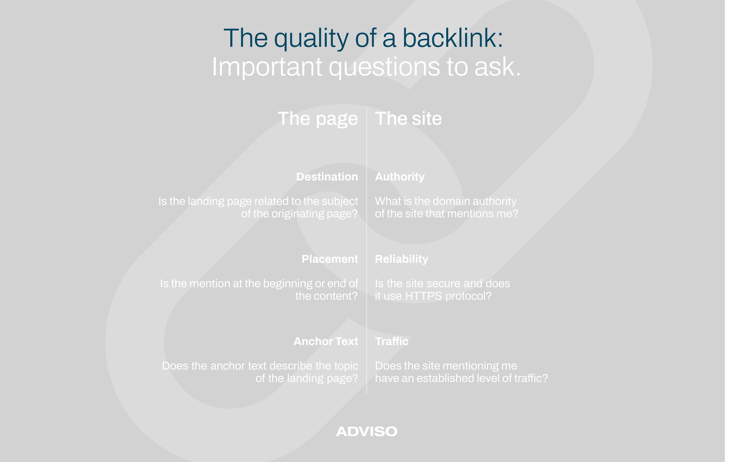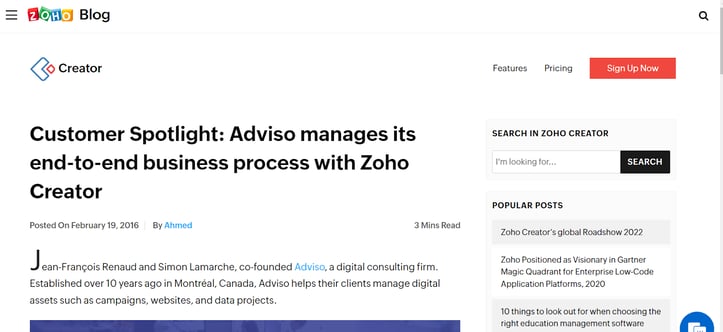SEO & Content Marketing Specialist
How to measure your company’s visibility using backlinks
SEO & Content Marketing Specialist
Google uses backlinks to determine how recognized a site is. In addition to being one of the main tools used in SEO to measure a company’s visibility on the web, it also provides an efficient way to increase the indexing of and traffic to your pages in the SERP (or “search engine result page”).
If you’re familiar with the issue of backlinks, then you probably already know that there’s no fast way to create them. Acquiring backlinks is a laborious process that sometimes feels discouraging. Hard to obtain and coveted for their effectiveness, backlinks are to marketing specialists what the Ring is to Sauron: a powerful tool that’s hard to get your hands on.
To help solve this problem, you can perform a backlink audit. This process will let you not only refine your netlinking strategy, but also help you focus your effort in the right areas, thereby facilitating the creation of high-quality links with a good return on investment.
In this article, after defining in greater detail exactly what these infamous backlinks are, we’ll attempt to answer the following questions:
- Why are backlinks so useful for your organic performance?
- How can you measure your influence with a backlink audit?
- Why is a backlink audit a reliable tool to help you increase your visibility?
Let’s get into it!
What are backlinks?
Backlinks, also called “inbound links” or “incoming links,” are links integrated into content presented on other websites that redirect the user to your site. In general, they’re used to assure the reader of the credibility of a piece of information by directing users to its source.
As an example, in the screenshot below, when ZOHO Analytics mentions our agency, they integrate a link into our name redirecting the reader to our website. This means ZOHO has generated a new outside link to our domain.
Why are backlinks so useful for organic performance?
Backlinks indicate to Google that you are an authoritative resource in your sector of activity. If many sites mention you, search engines will conclude that your content is perceived as a reliable, high-quality source of information by other users.
The idea of backlinks is therefore very similar to word-of-mouth: The more people talk about you, the more they refer to your website, the better the chances that Google will interpret this popularity as proof that you offer content worthy of interest.
Thus, slowly but surely, backlinks to your site will contribute to increasing your domain authority, a measurement created by Moz that aims to determine the probability that a website will be properly ranked in search engine result pages.
Basically, the higher the authority of your domain, the greater the chances that Google will boost it in its search results, thereby improving your site’s visibility. Because of this increased visibility, you’ll benefit from better indexing and, most likely, better traffic to your pages.
Not all backlinks have the same value
However, as with everything, it’s not a perfect solution: Not all mentions are good ones and not all backlinks have the same level of importance.
To look at just one example, what about platforms that sell inbound links on their website, which are commonly referred to as “link farms”? This solution provides a seemingly attractive shortcut by offering a faster way for your company to generate backlinks. However, purchasing this type of link is not recommended, since this practice promotes the creation of artificial links which runs counter to Google’s recommendations on the subject.
Remember that, for backlinks as well as many other things, quality is as important as quantity.
What is a good quality link in Google’s view?
Google has various criteria to determine the quality of a link. It naturally analyzes the site itself, but it also looks at its content.
Here are the main features Google takes into consideration when evaluating the quality of a website:
- Domain authority: Within the same sector of activity, the weight of a link to an SME will definitely be considered as inferior to one to a big company, because the SME’s authority will probably also be lower.
- Reliability: This is analyzed particularly in terms of security. For example, an unsecured website using http protocol is not considered to be a reliable URL by Google.
- Traffic: A high level of traffic to a site can be an indication that the content available is of good quality.
- Relevance of content: This is evaluated based on the subject being targeted. For example, the fact that a bank receives a backlink from a pet shop doesn’t make a lot of sense, given the context of activity.
- Anchor text: This must be logical and coherent. For example, clickable text saying “pet shop” that redirects to a page for car rentals is misleading and detrimental to user experience.
- Placement: The location where the link is positioned sometimes provides an indication of its degree of importance. For example, a mention placed at the start of an article often signals the importance of the content offered by the website you are being redirected to.
To sum up, a good quality link is properly configured, comes from a reliable site with an established level of traffic, and provides content that is interesting and consistent with your service offering.

Does my company have a good backlink profile?
The quality of a company’s backlink profile depends on the number of high-quality incoming links that redirect to their website. A domain receiving a greater number of quality links than its competitors will be assigned a good profile.
A comparative analysis of inbound links can be performed using marketing analytics tools like Ahrefs or Semrush. This analysis is a component of a backlink audit.
How can you measure your influence with a backlink audit?
A backlink audit is a document evaluating all inbound links pointing to your website.
In other words, it’s an exercise that enables you to measure the current state of your influence by studying your backlinks, so you can prioritize the acquisition strategies that best suit your situation.
This document can be useful as part of a netlinking campaign optimization process, particularly because it ensures good strategic alignment.
Why is a backlink audit a reliable tool to help you increase your visibility?
1. It verifies the quantity and quality of your backlinks
A good backlink audit will help you discover how many inbound links point to your website as well as evaluate their authority. Once this data is collected, you can establish a profile of the websites that mention you. You can also determine if there is a difference between the kind of mentions that you receive and the kind you would prefer to obtain.
This important information will also help you draw up a list of the quality criteria you would like your future prospects to fulfill. This activity simultaneously allows you to evaluate the quality of the management of your current links and to correct any bad practices employed internally.
2. It studies the way in which your competitors acquire and manage their own inbound links
A backlink audit reveals how your competitors manage their links and their strategies for obtaining them. You can take inspiration from what has worked for them and integrate these strategies into your own netlinking.
You’ll also find companies in your industry with major potential that have already mentioned your competitors, but have not already done you the honour. The audit will show the mentions that you might compete with, those to which your company could be added, as well as popular topics you could address in the future.
3. It locates new business partners
Once you’ve identified the influential sites that have already mentioned you, the backlink audit will enable you to determine the factors that led to that success and allowed you to obtain those quality links. You will then have the possibility of developing lasting relationships with these sources, with a view of promoting even more incoming links from these sites.
For example, if you notice that your company has already been mentioned in an article in La Presse, it would be beneficial to learn more about the fields of interest of the writer of that article. You could even contact this person directly to propose other content that is likely to be of interest and, potentially, published in the same newspaper.
Making these types of contacts is a central part of a successful backlink acquisition strategy.
4. It highlights content that should be focused on
Content that receives a lot of backlinks is actually an indicator of popularity. In concrete terms, it’s a sign that the information on the page is useful to other people. By listing out and examining these pages in a backlink audit, you will be able to adjust the content you create to focus your effort on what you know already works. The time you’ll save by approaching the issue in this way will help you create content that is easily shareable by sources that have already directed their users to your company, or even by new sources worthy of interest, which you’ve already identified through the audit.
5. It serves to establish a plan for building and increasing your authority
In short, a backlink audit gives you the tools you need to develop a well-constructed link acquisition strategy. The exercise will help you save time searching for prospects while letting you determine the best opportunities for placement on credible sites that are authoritative within your field of activity.
By basing your strategy on such a solid footing and applying good practices from the start, you’ll be able to build and increase your site’s authority more quickly, while simultaneously improving its organic performance.
Backlinks directly influence the standing of your company on the web. Unfortunately, the quest for mentions that are likely to make a difference may often seem more like crossing a desert.
Investing in a backlink audit will not only help you save resources, but also give you a clear view of your situation and a detailed portrait of the most effective next steps your company should take.
Like a compass, it will show you what path you should follow and ensure you’re heading in the right direction.
Want to learn more?
Contact our specialists, who would be happy to help.





